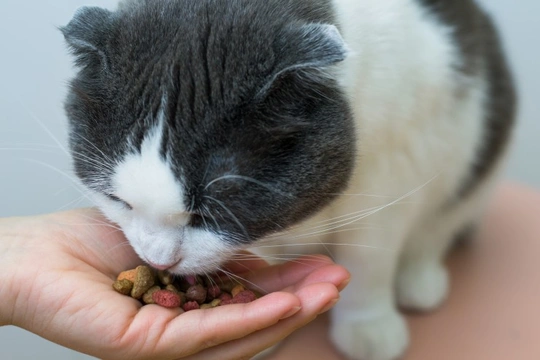
Why do cats sometimes miss treats put right in front of them?
Cats are very efficient hunters, and they have great eyesight for detecting the smallest movements of the smallest prey animals nearby. Cats will often sit very still for long periods of time watching bushes and areas of undergrowth where prey might be found, and when this eventually pays off with the rustle or the slightest movement of a rodent or bird, they pounce and carry off their prize.
If you’ve ever watched your cat play or mock-hunt as part of a game, you have probably seen how intently they will focus on the task at hand, tracking the toy’s movement with great precision and never losing sight of it.
However, most of us have spotted a rather incongruous behaviour on the part of our cats when it comes to their vision too; cats sometimes miss or appear not to see treats that are put down right in front of them.
If you’ve got your cat’s attention by rustling the bag of Dreamies and shaking out a few treats for them that they obviously know are coming and that they are waiting for, your cat’s seeming inability to see the treats that are right in front of their nose whilst clamouring for a reward can be confusing.
Before you start questioning whether or not your cat is losing their vision, you first need to understand how your cat’s eyesight works, and why they can see some things so well and yet, miss others.
In this article we will explain why cats often seem to fail to see treats put down in front of them, and how your cat’s vision might be allowing this to happen whilst still being perfectly functional. Read on to learn more.
How well can cats see close up?
The way that the vision of your cat works is rather different to your own, because humans and cats have evolved with the appropriate traits to survive and thrive in their natural environments, and to deal with the challenges that they face within it.
In terms of the size of your cat’s eyes compared to their bodies, your cat’s eyes are very large, and their pupils are larger than ours too, in order to allow the maximum amount of light to enter the eye to improve vision in the dark and in dim lighting.
This is why cats tend to hunt most prolifically at around dusk and dawn.
Cats have evolved with a high degree of acuity to their eyesight when it comes to being able to identify movement, particularly close up. This is because cats hunt up close, as evinced by the watching and waiting that they undertake before they pounce on something.
Just like humans, cats can be near sighted or far sighted, and most cats tend to be near sighted to a certain extent, which again reflects what they need to hunt and survive. Cats that are quite sedentary, that rarely go outside or that live indoor-only lives also tend to be rather more near sighted than most too, as our vision adapts over time to the situations and environments that we face regularly.
Just as your cat’s large eyes and pupils help them to get enough light to see in less than optimum conditions, there is a trade-off for this, however. The size of your cat’s eyes and the pupils themselves limit your cat’s ability to focus on objects that are very close to them – generally anything nearer than around 20-30cm away will be slightly unclear, and anything closer than this will likely fall outside of your cat’s field of vision entirely.
This means that if you put treats right in front of your cat or directly under their nose, they won’t be able to see them immediately, and may not even realise that they are there.
Why can’t cats see treats right under their noses?
If you put your cat’s treats right in front of them or close enough that they are immediately in their reach, it can be a bit of a puzzler when your cat acts as if they can’t see them or don’t know where you have put them.
However, if your cat knows that a treat is in the vicinity, they integrate the use of their other senses as well in order to find it. Cats can of course smell a treat when it is close enough to them, but your cat’s sense of smell is nowhere near as good as that of the dog, and treats (which don’t tend to be particularly strongly scented when we talk about commercially sold treats rather than fresh foods like tuna) will often be missed when sniffing around unless your cat gets very close to them.
However, your cat’s whiskers are very sensitive and transmit messages through touch back to the brain, and so if your cat is snuffling around trying to find their treats, their whiskers will help to direct them.
Your cat’s vision is better designed to pick up movement than it is static objects, so if you drop the treats in front of your cat while they are watching, this movement provides them with a clue. Your cat is also likely to spot their treats right away if you shake the bag and then drop a few treats a couple of feet away, where they will fall more squarely into your cat’s field of vision.



